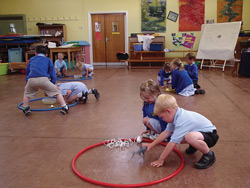Developing creative thinking
Add to My Folder
Discover the secrets and strategies that will turn your children into confident, creative thinkers

Children from a First School in Northumberland try various ‘oddone out’ activities
In 1991 Dr Jim Moran and his colleagues from Tennessee University published an article entitled ‘Creativity in Early Childhood Classrooms’ (DW Tegano et al, National Education Association, Washington DC). In it they stated that, according to their research, the percentage of original responses offered by children during ‘brainstorming’ activities drops from about 50 per cent among four-year-olds to 25 per cent during the primary school years. They concluded that the structured materials used in schools, and the instructions offered by teaching staff, reduced the flexibility of children and discouraged creativity.
A metaphor for creativity…

Imagine you’re at a party, a large Christmas party. You walk into the room and there, in front of you, are more than 200 partygoers all having a seemingly good time. What do you do? First things first; you head for the bar and get yourself a drink. Then you scan the room looking for someone – anyone – you know. You spot a colleague from work and you’re off, making a beeline for them. You greet them, perhaps overenthusiastically, and begin the process of settling in to the party, chatting with them as if you haven’t seen them all year (though of course you saw them this morning shouting at the little darlings for fluffing their Nativity Play lines). As you listen to them ‘intently’ you use your peripheral vision to spot someone else you know because you can’t stand chatting to your colleague all night and at the same time give the impression of being a social diva. Then you spot a friend of a friend. She is at the centre of a big group of interesting-looking people who are very obviously enjoying her company, judging by the amount of laughter. The next minute she is across the other side of the room being far too tactile with a very handsome young man. Before long she is chatting up the boss, no doubt putting in a good word for herself. You’re left thinking – why can’t I be more like her?
This is not my attempt at creative writing; instead, I’d like to use this as a metaphor for creativity. The friend of a friend is the creative type – the artistic or musical one who always seems to see things differently (and more interestingly); whereas you are following the ‘normal’ patterns of behaviour, making connections in the same way that most others do, thinking the same way, acting the same way. And that makes you normal. But not creative.
Every time we make a connection, other possible connections are neglected. So, when you make a beeline for your colleague, you neglect the possibility of making a beeline for the handsome stranger in the corner. Similarly, in the brain, every new experience or thought causes some neurons to connect and others to deteriorate. Over time, as we make similar connections, patterns are formed then reinforced and, before we know it, we’re ‘stuck in our ways’. But it doesn’t have to be like this. If we systematically look for new, and different, connections we can learn to be more creative and more interesting.
Scholastic Resource Bank: Primary - join today!
- Over 6,000 primary activities, lesson ideas and resources
- Perfect for anyone working with children from 5 to 11 years old
- Unlimited access from just £1.25 per month
Already a member? Sign in below.
Published 28 May 2008
Reviews
You need to be signed in to place a review.